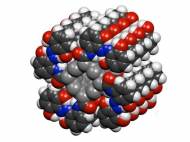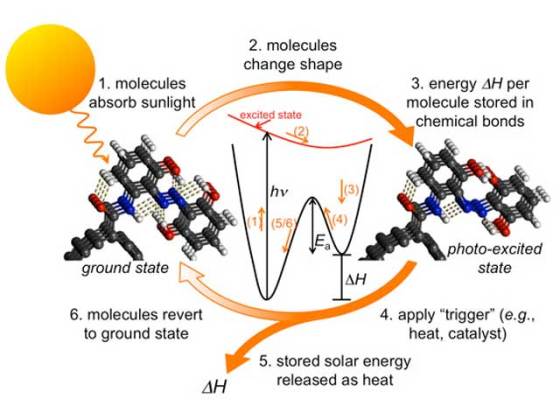Storing solar energy indefinitely now possible thanks to carbon nanotubes
 The idea of reversibly storing solar energy in chemical bonds is gaining a lot of attention these days. A group of researchers from MIT have developed a novel application of carbon nanotubes which shows potential as an effective approach to store solar energy for use whenever it’s needed. The method simplifies the process by combining energy harvesting and storage into a single step.
The idea of reversibly storing solar energy in chemical bonds is gaining a lot of attention these days. A group of researchers from MIT have developed a novel application of carbon nanotubes which shows potential as an effective approach to store solar energy for use whenever it’s needed. The method simplifies the process by combining energy harvesting and storage into a single step.
Previously, the chemicals used to achieve this type of conversion and storage either degraded within a few cycles, or included the element ruthenium, which is rare and expensive. Jeffrey Grossman, the Carl Richard Soderberg Associate Professor of Power Engineering at MIT, and postdoc Alexie Kolpak have created a new material which is a combination of carbon nanotubes and a compound called azobenzene.
Produced by using nanoscale templates to shape and constrain their physical structure, the resulting molecules gain new properties that aren’t available in the separate materials. Thermo-chemical storage of solar energy uses a molecule whose structure changes when exposed to sunlight, and can remain stable in that form indefinitely. Activated by a stimulus (such as a small temperature change or a flash of light), it can quickly release its stored energy in a burst of heat.
The key of controlling solar thermal storage is an energy barrier separating the two stable states the molecule can adopt. If the barrier was too low, the molecule would easily return to its “uncharged” state, failing to store energy for long periods. On the other hand, if the barrier was too high, the molecule would not be able to easily release its energy when needed.
While their findings show the energy-storage capability of a specific type of molecule, the researchers claim the way the material was designed involves a general concept that can be applied to many new materials. Many of these have already been synthesized by other researchers for different applications, and would simply need to have their properties fine-tuned for solar thermal storage.
One of the great advantages of this approach in harnessing solar energy is the fact that the material is capable to both convert and store energy. It’s robust, it doesn’t degrade, and it is cheaper than the ruthenium-containing compound, but it is also 10,000 times more efficient at storing energy in a given amount of space.
For more information, you can read the article published in the journal Nano Letters named: “Azobenzene-Functionalized Carbon Nanotubes As High-Energy Density Solar Thermal Fuels” [3.64MB PDF].










Excellent research by MIT Researchers on carbon nanotubes for storing Solar Energy.This will boost up usage of solar energy at micro level.
Dr.A.Jagadeesh Nellore(AP),India
Wind Energy Expert
E-mail: anumakonda.jagadeesh@gmail.com
This technology is definitely going to make a difference in energy management. My question is, what is it’s rate of storage? Can it be applied to other technology which needs energy storage such as automobiles?
author
Back when this article was published, the research paper was accessible by public or I wouldn’t put the “you can read” part, but I found the research paper on the page of the Grossman Group and added it as a PDF link.
You could compare this technology to other thermal energy storage systems such as molten salts, and according to information that was found you can see they claim it is 10,000 times more efficient at storing energy in a given amount of space.
At the time, I believe the system had energy densities equivalent to lithium-ion batteries.